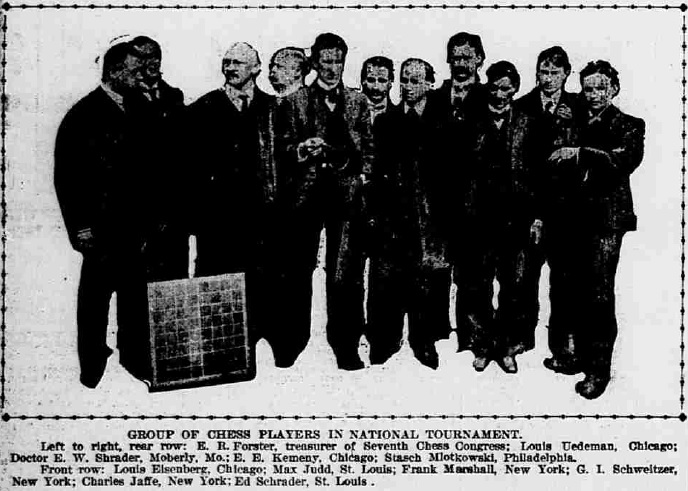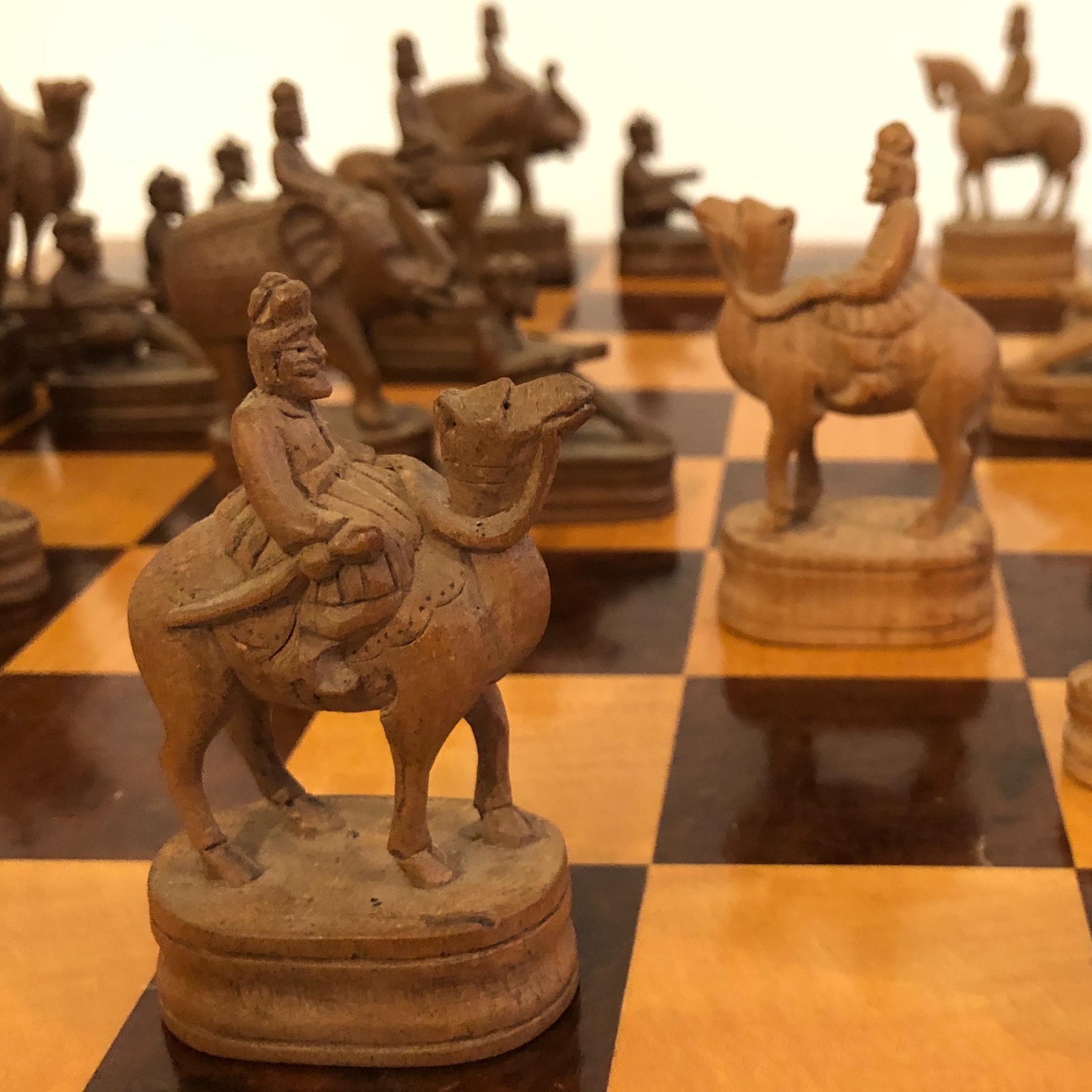|
Marshall Trap
The Marshall Trap is a chess opening in Petrov's Defence named after Frank Marshall. The trap 1. e4 e5 2. Nf3 Nf6 :The trap begins with Black playing Petrov's Defence. 3. Nxe5 d6 4. Nf3 Nxe4 5. d4 d5 6. Bd3 Bd6 7. 0-0 0-0 8. c4 Bg4 9. cxd5 f5 10. Re1? (see diagram) :White should play 10.Nc3 instead. 10... Bxh2+! :An unexpected blow. 11. Kxh2 :If 11.Nxh2, then 11...Bxd1. 11...Nxf2 :Black forks the white queen and bishop, forcing the queen to move. 12. Qe2 Nxd3 13. Qxd3 Bxf3 14. Qxf3 Qh4+ :Followed by 15...Qxe1 winning the e1-rook. Black has a winning material advantage. References *{{cite book, contribution = Marshall Trap , title = The Oxford Companion to Chess , last1 = Hooper , first1 = David , last2 = Whyld , first2 = Kenneth , author1-link = David Vincent Hooper , author2-link = Kenneth Whyld , year = 1996 , edition = 2nd , orig-year = First pub. 1992 , publisher = Oxford University Press Oxford University Press (OUP) is the university press ... [...More Info...] [...Related Items...] OR: [Wikipedia] [Google] [Baidu] |
Chess Opening
A chess opening or simply an opening is the initial stage of a chess game. It usually consists of established theory; the other phases are the middlegame and the endgame. Many opening sequences have standard names such as the " Sicilian Defense". '' The Oxford Companion to Chess'' lists 1,327 named openings and variants, and there are many others with varying degrees of common usage. Opening moves that are considered standard are referred to as "book moves", or simply "book". When a game begins to deviate from known opening theory, the players are said to be "out of book". In some openings, "book" lines have been worked out for over 30 moves, as in the classical King's Indian Defense and in the Najdorf variation of the Sicilian Defense. Professional chess players spend years studying openings, and continue doing so throughout their careers, as opening theory continues to evolve. Players at the club level also study openings but the importance of the opening phase is smalle ... [...More Info...] [...Related Items...] OR: [Wikipedia] [Google] [Baidu] |
Petrov's Defence
Petrov's Defence or the Petrov Defence (also called Petroff Defence, Petrov's Game, Russian Defence, or Russian Game – russian: Русская партия) is a chess opening characterised by the following moves: :1. e4 e5 :2. Nf3 Nf6 Though this response has a long history, it was first popularised by Alexander Petrov, a Russian chess player in the mid-19th century. In recognition of the early investigations by the Russian masters Petrov and Carl Jaenisch, this opening is called the Russian Game in some countries. The Petrov has a drawish reputation; however, it offers attacking opportunities for both sides, and a few lines are quite . Often a trade occurs and Black, after gaining a tempo, has a well-placed knight. Pillsbury's game in 1895 against Emanuel Lasker testifies to this. The Black counterattack in the centre also avoids the Ruy Lopez, Giuoco Piano (and other lines of the Italian Game), and the Scotch Game. The Petrov has been adopted by many of the world's ... [...More Info...] [...Related Items...] OR: [Wikipedia] [Google] [Baidu] |
Frank Marshall (chess Player)
Frank James Marshall (August 10, 1877 – November 9, 1944) was the U.S. Chess Champion from 1909 to 1936, and one of the world's strongest chess players in the early part of the 20th century. Chess career Marshall was born in New York City, and lived in Montreal, Quebec, Canada, from age 8 to 19. He began playing chess at the age of 10, and by 1890 (aged 13) was one of the leading players in Montreal. He won the 1904 Cambridge Springs International Chess Congress (scoring 13/15, ahead of World Champion Emanuel Lasker) and the U.S. Congress in 1904, but did not get the national title because the U.S. champion at that time, Harry Nelson Pillsbury, did not compete. In 1906 Pillsbury died and Marshall again refused the championship title until he won it in competition in 1909. In 1907 he played a match against World Champion Emanuel Lasker for the title and lost eight games, winning none and drawing seven. They played their match in New York City, Philadelphia, Washington, ... [...More Info...] [...Related Items...] OR: [Wikipedia] [Google] [Baidu] |
Fork (chess)
In chess, a fork is a tactic in which a piece multiple enemy pieces simultaneously. The attacker usually aims to capture one of the forked pieces. The defender often cannot counter every threat. A fork is most effective when it is forcing, such as when the king is put in check. A fork is a type of . Terminology A fork is an example of a . The type of fork is named after the type of forking piece. For example, a fork by a knight is a knight fork. The attacked pieces are ''forked''. If the King is one of the attacked pieces, the term ''absolute fork'' is sometimes used. A fork not involving the enemy king is in contrast a ''relative fork''. A fork of the king and queen, the highest material-gaining fork possible, is sometimes called a ''royal fork''. A fork of the enemy king, queen, and one (or both) rooks is sometimes called a ''grand fork''. A knight fork of the enemy king, queen, and possibly other pieces is sometimes called a ''family fork'' or ''family check''. Strategy ... [...More Info...] [...Related Items...] OR: [Wikipedia] [Google] [Baidu] |
Queen (chess)
The queen (♕, ♛) is the most powerful piece in the game of chess. It can move any number of squares vertically, horizontally or , combining the powers of the rook and bishop. Each player starts the game with one queen, placed in the middle of the first next to the king. Because the queen is the strongest piece, a pawn is promoted to a queen in the vast majority of cases. The predecessor to the queen is the '' ferz'', a weak piece only able to move or capture one step diagonally, originating from the Persian game of shatranj. The modern queen gained its power and its modern move in Spain in the 15th century during Isabella I's reign, perhaps inspired by her great political power. Placement and movement The white queen starts on d1, while the black queen starts on d8. With the chessboard oriented correctly, the white queen starts on a white square and the black queen starts on a black square—thus the mnemonics "queen gets her color", "queen on er wncolor", or "t ... [...More Info...] [...Related Items...] OR: [Wikipedia] [Google] [Baidu] |
Bishop (chess)
The bishop (♗, ♝) is a piece in the game of chess. It moves and captures along without jumping over intervening pieces. Each player begins the game with two bishops. One starts between the and the king, the other between the and the queen. The starting squares are c1 and f1 for White's bishops, and c8 and f8 for Black's bishops. Placement and movement The king's bishop is placed between the king and the king's knight, f1 for White and f8 for Black; the queen's bishop is placed between the queen and the queen's knight, c1 for White and c8 for Black. The bishop has no restrictions in distance for each move but is limited to diagonal movement. It cannot jump over other pieces. A bishop captures by occupying the square on which an enemy piece stands. As a consequence of its diagonal movement, each bishop always remains on one square color. Due to this, it is common to refer to a bishop as a light-squared or dark-squared bishop. Comparison – other pieces Versus rook A ... [...More Info...] [...Related Items...] OR: [Wikipedia] [Google] [Baidu] |
Rook (chess)
The rook (; ♖, ♜) is a piece in the game of chess. It may move any number of squares horizontally or vertically without jumping, and it may an enemy piece on its path; additionally, it may participate in castling. Each player starts the game with two rooks, one in each corner on their own side of the board. Formerly, the rook (from Persian رخ ''rokh''/''rukh'', meaning "chariot") was alternatively called the tower, marquess, rector, and comes (count or earl). The term "castle" is considered to be informal, incorrect, or old-fashioned. Placement and movement The white rooks start on squares a1 and h1, while the black rooks start on a8 and h8. The rook moves horizontally or vertically, through any number of unoccupied squares (see diagram). The rook cannot jump over pieces. The rook may capture an enemy piece by moving to the square on which the enemy piece stands, removing it from play. The rook also participates with the king in a special move called castling, wherein it ... [...More Info...] [...Related Items...] OR: [Wikipedia] [Google] [Baidu] |
The Oxford Companion To Chess
''The Oxford Companion to Chess'' is a reference book on the game of chess written by David Vincent Hooper and Kenneth Whyld. The book is written in an encyclopedia format. The book belongs to the Oxford Companions series. Details The first edition of the book was published in 1984 by Oxford University Press. The second edition (1992) has over 2,500 entries, including rules of chess, rules, list of chess terms, terms, chess strategy, strategies, chess tactics, tactics, over 500 brief biographies of famous players, and entries on more than 700 named chess opening, openings and opening variations. In the back of the book is a comprehensive index of opening variations and sub-variations, listing 1,327 named variations. The book also discusses chess from other countries (such as shogi), chess variants (such as three dimensional chess), and some forms of fairy chess. Editions * First published in 1984 by Oxford University Press * Reissued in paperback (with corrections) in 1987 by ... [...More Info...] [...Related Items...] OR: [Wikipedia] [Google] [Baidu] |
Oxford University Press
Oxford University Press (OUP) is the university press of the University of Oxford. It is the largest university press in the world, and its printing history dates back to the 1480s. Having been officially granted the legal right to print books by decree in 1586, it is the second oldest university press after Cambridge University Press. It is a department of the University of Oxford and is governed by a group of 15 academics known as the Delegates of the Press, who are appointed by the vice-chancellor of the University of Oxford. The Delegates of the Press are led by the Secretary to the Delegates, who serves as OUP's chief executive and as its major representative on other university bodies. Oxford University Press has had a similar governance structure since the 17th century. The press is located on Walton Street, Oxford, opposite Somerville College, in the inner suburb of Jericho. For the last 500 years, OUP has primarily focused on the publication of pedagogical texts a ... [...More Info...] [...Related Items...] OR: [Wikipedia] [Google] [Baidu] |




.jpg)